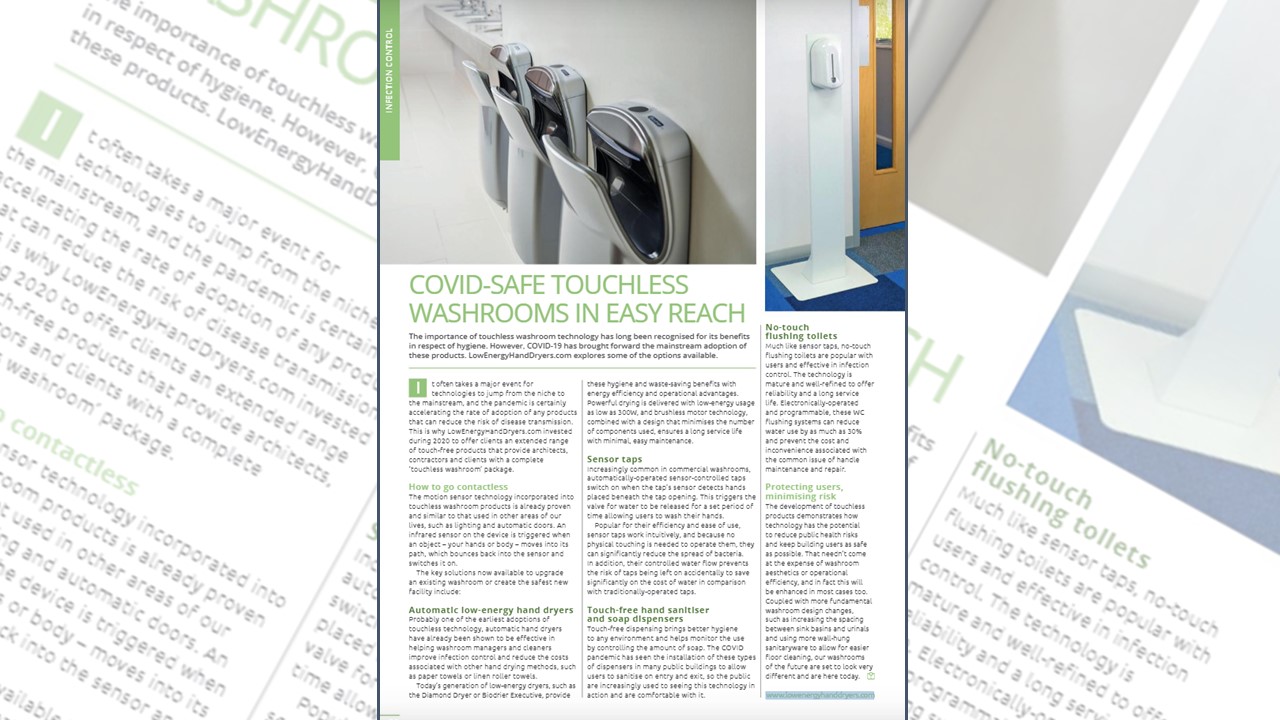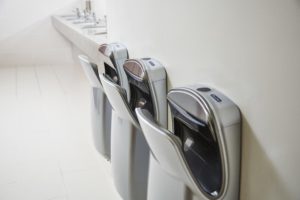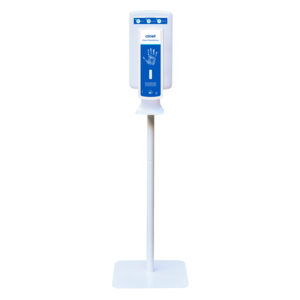Covid-safe touchless washrooms in easy reach
February 2, 2021

Commercial washrooms are continuously evolving in line with consumer trends, legislative changes and aesthetics, as well as to respond to emerging health threats. The arrival of Covid-19 in 2020 has prompted perhaps the most urgent response to change in living memory in respect of the way buildings of all kinds are designed and used, and washroom configuration is already undergoing major changes.

 As published in the February 2021 issue of Public Sector Build Journal - read the magazine online here.
As published in the February 2021 issue of Public Sector Build Journal - read the magazine online here.
The importance of touchless washroom technology has long been recognised for its benefits in respect of hygiene. Being able to operate a tap or hand dryer without having to touch the device is something most washroom users will already be familiar with. The Covid-19 pandemic has brought into sharp focus these kinds of solutions as public health advice continues to remind us to minimise the touching of surfaces when we’re out in public.
 It often takes a major event for technologies to jump from the niche to the mainstream, and the pandemic is certainly accelerating the rate of adoption of any products that can reduce the risk of disease transmission. This is why LowEnergyHandDryers.com has invested during 2020 to offer clients an extended range of touch-free products that provide architects, contractors and clients with a complete ‘touchless washroom’ package.
It often takes a major event for technologies to jump from the niche to the mainstream, and the pandemic is certainly accelerating the rate of adoption of any products that can reduce the risk of disease transmission. This is why LowEnergyHandDryers.com has invested during 2020 to offer clients an extended range of touch-free products that provide architects, contractors and clients with a complete ‘touchless washroom’ package.
How to go contactless
The motion sensor technology incorporated into touchless washroom products is already proven and similar to that used in other areas of our lives, such as lighting and automatic doors. An infra-red sensor on the device is triggered when an object - your hands or body – moves into its path, which bounces back into the sensor and switches it on.
The key solutions now available to upgrade an existing washroom or create the safest new facility include:
Automatic low energy hand dryers
Probably one of the earliest adoptions of touchless technology, automatic hand dryers have already been shown to be effective in helping washroom managers and cleaners improve infection control and reduce the costs associated with other hand drying methods, such as paper towels or linen roller towels.
Today’s generation of low energy dryers such as the Diamond Dryer or Biodrier Executive provide these hygiene and waste-saving benefits with energy efficiency and operational advantages. Powerful drying is delivered with low energy usage as low as 300W, and brushless motor technology combined with a design that minimises the number of components used ensures a long service life with minimal and easy maintenance.
The Biodrier Executive also brings another important benefit to help combat Covid-19 transmission - incorporation of a Grade 13 HEPA filter. HEPA filters are mechanical filters with a capacity for sifting small particles at a much higher rate than any other conventional filter. An HEPA H13 filter is capable of blocking up to 99.95% of Maximum Penetration Size Particles (MPPS). This means it is effective at filtering the particles to which the Covid-19 virus is attached with ease, trapping the infected droplets and preventing them from re-circulating into the washroom.
UV air purifiers and sanitisers
Another way to deal with airborne viruses – as well as bad odours – is via a UV air purifier. These units can be installed within the washroom to filter air 24/7 using a combination of sterilising techniques that have been shown to destroy viruses including Covid-19, influenza, H1N1, H5N1, E.coli, Salmonella and Streptococcus. The BioZone AirCare unit represents the most effective option and is, therefore, an important additional measure to help reduce Covid-19 transmission.
Sensor taps
Increasingly common in commercial washrooms, automatically operated sensor controlled taps switch on when the tap’s sensor detects hands placed beneath the tap opening. This triggers the valve for water to be released for a set period of time allowing users to wash their hands.
Popular for their efficiency and ease of use, sensor taps work intuitively, and because no physical touching is needed to operate them, they can significantly reduce the spread of bacteria. In addition, their controlled water flow prevents the risk of taps being left on accidentally to save significantly on the cost of water in comparison with traditionally operated taps.
Cubicle door openers
Door handles are increasingly being seen as a major risk in infection control which is why fully automatic, touchless toilet cubicle door systems are gaining in popularity. By installing an automatic door opener with a touch-free kit, a system can be provided which allows users to access the toilet without having any need to touch a surface.
Automatically opening doors have become commonplace as building owners and managers have sought to improve access for those with disabilities, but we can go much further and cubicle opening and closing may now be touchless too.
A door kit featuring a motion sensor is fixed to the door. A user simply needs to raise their hand next to the sensor in order to open the door and if the cubicle is in use a red light will flash on the device. Once inside, the user raises their hand towards the internal sensor to lock the door. To exit, it is the same principle – simply raise your hand in front of the sensor and the door will unlock.
Touch-free hand sanitiser and soap dispensers
Touch free dispensing brings better hygiene to any environment and helps monitor the use by controlling the amount of soap. The Covid pandemic has seen the installation of these types of hand sanitiser dispensers in many public buildings to allow users to sanitise on entry and exit, so the public are increasingly used to seeing this technology in action and are comfortable with it.
No touch flushing toilets
Much like sensor taps, no-touch flushing toilets are popular with users and effective in infection control. The technology is mature and well-refined to offer reliability and a long service life. Electronically operated and programmable, these WC flushing systems can reduce water use by as much as 30% and prevent the cost and inconvenience associated with the common issue of handle maintenance and repair.
Contactless payment vending machines
Whether it is buying a car park ticket or snacks at a train station, more vending machines than ever before are offering contactless card payments. That same technology is also now available for washroom vending machines which are an integral part of many commercial facilities to accommodate all sorts of hygiene and sanitary products. The application of this payment technology for these dispensers provides the scope to really optimise the touch-free washroom and ensure every area has been addressed.
Protecting users, minimising risk
The development of touchless products demonstrates how technology has the potential to reduce public health risks and keep building users as safe as possible. That needn’t come at the expense of washroom aesthetics or operational efficiency, and in fact this will be enhanced in most cases too. Coupled with more fundamental washroom design changes, such as increasing the spacing between sink basins and urinals and using more wall-hung sanitary ware to allow for easier floor cleaning, our washrooms of the future are set to look very different and are here today.
To find out more about creating the touchless commercial or public washroom please contact us.
Commercial washrooms are continuously evolving in line with consumer trends, legislative changes and aesthetics, as well as to respond to emerging health threats. The arrival of Covid-19 in 2020 has prompted perhaps the most urgent response to change in living memory in respect of the way buildings of all kinds are designed and used, and washroom configuration is already undergoing major changes.

![]() As published in the February 2021 issue of Public Sector Build Journal - read the magazine online here.
As published in the February 2021 issue of Public Sector Build Journal - read the magazine online here.
The importance of touchless washroom technology has long been recognised for its benefits in respect of hygiene. Being able to operate a tap or hand dryer without having to touch the device is something most washroom users will already be familiar with. The Covid-19 pandemic has brought into sharp focus these kinds of solutions as public health advice continues to remind us to minimise the touching of surfaces when we’re out in public.
 It often takes a major event for technologies to jump from the niche to the mainstream, and the pandemic is certainly accelerating the rate of adoption of any products that can reduce the risk of disease transmission. This is why LowEnergyHandDryers.com has invested during 2020 to offer clients an extended range of touch-free products that provide architects, contractors and clients with a complete ‘touchless washroom’ package.
It often takes a major event for technologies to jump from the niche to the mainstream, and the pandemic is certainly accelerating the rate of adoption of any products that can reduce the risk of disease transmission. This is why LowEnergyHandDryers.com has invested during 2020 to offer clients an extended range of touch-free products that provide architects, contractors and clients with a complete ‘touchless washroom’ package.
How to go contactless
The motion sensor technology incorporated into touchless washroom products is already proven and similar to that used in other areas of our lives, such as lighting and automatic doors. An infra-red sensor on the device is triggered when an object - your hands or body – moves into its path, which bounces back into the sensor and switches it on.
The key solutions now available to upgrade an existing washroom or create the safest new facility include:
Automatic low energy hand dryers
Probably one of the earliest adoptions of touchless technology, automatic hand dryers have already been shown to be effective in helping washroom managers and cleaners improve infection control and reduce the costs associated with other hand drying methods, such as paper towels or linen roller towels.
Today’s generation of low energy dryers such as the Diamond Dryer or Biodrier Executive provide these hygiene and waste-saving benefits with energy efficiency and operational advantages. Powerful drying is delivered with low energy usage as low as 300W, and brushless motor technology combined with a design that minimises the number of components used ensures a long service life with minimal and easy maintenance.
The Biodrier Executive also brings another important benefit to help combat Covid-19 transmission - incorporation of a Grade 13 HEPA filter. HEPA filters are mechanical filters with a capacity for sifting small particles at a much higher rate than any other conventional filter. An HEPA H13 filter is capable of blocking up to 99.95% of Maximum Penetration Size Particles (MPPS). This means it is effective at filtering the particles to which the Covid-19 virus is attached with ease, trapping the infected droplets and preventing them from re-circulating into the washroom.
UV air purifiers and sanitisers
Another way to deal with airborne viruses – as well as bad odours – is via a UV air purifier. These units can be installed within the washroom to filter air 24/7 using a combination of sterilising techniques that have been shown to destroy viruses including Covid-19, influenza, H1N1, H5N1, E.coli, Salmonella and Streptococcus. The BioZone AirCare unit represents the most effective option and is, therefore, an important additional measure to help reduce Covid-19 transmission.
Sensor taps
Increasingly common in commercial washrooms, automatically operated sensor controlled taps switch on when the tap’s sensor detects hands placed beneath the tap opening. This triggers the valve for water to be released for a set period of time allowing users to wash their hands.
Popular for their efficiency and ease of use, sensor taps work intuitively, and because no physical touching is needed to operate them, they can significantly reduce the spread of bacteria. In addition, their controlled water flow prevents the risk of taps being left on accidentally to save significantly on the cost of water in comparison with traditionally operated taps.
Cubicle door openers
Door handles are increasingly being seen as a major risk in infection control which is why fully automatic, touchless toilet cubicle door systems are gaining in popularity. By installing an automatic door opener with a touch-free kit, a system can be provided which allows users to access the toilet without having any need to touch a surface.
Automatically opening doors have become commonplace as building owners and managers have sought to improve access for those with disabilities, but we can go much further and cubicle opening and closing may now be touchless too.
A door kit featuring a motion sensor is fixed to the door. A user simply needs to raise their hand next to the sensor in order to open the door and if the cubicle is in use a red light will flash on the device. Once inside, the user raises their hand towards the internal sensor to lock the door. To exit, it is the same principle – simply raise your hand in front of the sensor and the door will unlock.
Touch-free hand sanitiser and soap dispensers
Touch free dispensing brings better hygiene to any environment and helps monitor the use by controlling the amount of soap. The Covid pandemic has seen the installation of these types of hand sanitiser dispensers in many public buildings to allow users to sanitise on entry and exit, so the public are increasingly used to seeing this technology in action and are comfortable with it.
No touch flushing toilets
Much like sensor taps, no-touch flushing toilets are popular with users and effective in infection control. The technology is mature and well-refined to offer reliability and a long service life. Electronically operated and programmable, these WC flushing systems can reduce water use by as much as 30% and prevent the cost and inconvenience associated with the common issue of handle maintenance and repair.
Contactless payment vending machines
Whether it is buying a car park ticket or snacks at a train station, more vending machines than ever before are offering contactless card payments. That same technology is also now available for washroom vending machines which are an integral part of many commercial facilities to accommodate all sorts of hygiene and sanitary products. The application of this payment technology for these dispensers provides the scope to really optimise the touch-free washroom and ensure every area has been addressed.
Protecting users, minimising risk
The development of touchless products demonstrates how technology has the potential to reduce public health risks and keep building users as safe as possible. That needn’t come at the expense of washroom aesthetics or operational efficiency, and in fact this will be enhanced in most cases too. Coupled with more fundamental washroom design changes, such as increasing the spacing between sink basins and urinals and using more wall-hung sanitary ware to allow for easier floor cleaning, our washrooms of the future are set to look very different and are here today.
To find out more about creating the touchless commercial or public washroom please contact us.
